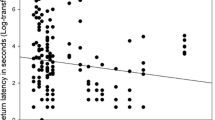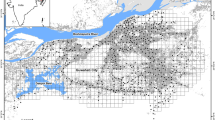Abstract
Wild animals living in proximity to humans may benefit from recognizing people individually and adjusting their behaviour to the potential risk or gain expected from each person. Although several urban-dwelling species exhibit such skills, it is unclear whether this is due to pre-existing advanced cognitive abilities of taxa predisposed for city life or arises specifically in urban populations either by selection or through ontogenetic changes facilitated by exposure to humans. To test these alternatives, we studied populations of house sparrows (Passer domesticus) along the urbanization gradient. We manipulated the birds’ experience (hostile or not) associated with humans with different faces (masks) and measured their behavioural responses to the proximity of each person. Contrary to our expectations, we found that while rural birds showed less fear of the non-hostile than of the hostile or an unfamiliar person, urban birds made no distinction. These results indicate that house sparrows are less able to recognize individual humans or less willing to behaviourally respond to them in more urbanized habitats with high human population density. We propose several mechanisms that may explain this difference, including reduced pay-off of discrimination due to a low chance of repeated interactions with city people, or a higher likelihood that city people will ignore them.



Similar content being viewed by others
References
Anderson TR (2006) Biology of the ubiquitous house sparrow: from genes to populations. Oxford University Press, New York
Belguermi A, Bovet D, Pascal A, Prévot-Julliard A-C, Saint Jalme M, Rat-Fischer L, Leboucher G (2011) Pigeons discriminate between human feeders. Anim Cogn 14:909–914. doi:10.1007/s10071-011-0420-7
Benjamini Y, Drai D, Elmer G, Kafkafi N, Golani I (2001) Controlling the false discovery rate in behavior genetics research. Behav Brain Res 125:279–284
Bókony V, Kulcsár A, Liker A (2010) Does urbanization select for weak competitors in house sparrows? Oikos 119:437–444. doi:10.1111/j.1600-0706.2009.17848.x
Bókony V, Seress G, Nagy S, Lendvai ÁZ, Liker A (2012) Multiple indices of body condition reveal no negative effect of urbanization in adult house sparrows. Landsc Urban Plan 104:75–84. doi:10.1016/j.landurbplan.2011.10.006
Bókony V, Lendvai ÁZ, Vágási CI, Pătraş L, Pap PL, Németh J, Vincze E, Papp S, Preiszner B, Seress G, Liker A (2014) Necessity or capacity? Physiological state predicts problem-solving performance in house sparrows. Behav Ecol 25:124–135. doi:10.1093/beheco/art094
Boogert NJ, Monceau K, Lefebvre L (2010) A field test of behavioural flexibility in Zenaida doves (Zenaida aurita). Behav Processes 85:135–141. doi:10.1016/j.beproc.2010.06.020
Carrete M, Tella JL (2011) Inter-individual variability in fear of humans and relative brain size of the species are related to contemporary urban invasion in birds. PLoS ONE 6:e18859. doi:10.1371/journal.pone.0018859
Carter J, Lyons NJ, Cole HL, Goldsmith AR (2008) Subtle cues of predation risk: starlings respond to a predator’s direction of eye-gaze. Proc R Soc B 275:1709–1715. doi:10.1098/rspb.2008.0095
Clucas B, Marzluff JM (2012) Attitudes and actions toward birds in urban areas: human cultural differences influence bird behavior. Auk 129:8–16. doi:10.1525/auk.2011.11121
Cook RG, Levison DG, Gillett SR, Blaisdell AP (2005) Capacity and limits of associative memory in pigeons. Psychon Bull Rev 12:350–358
Davis H, Gibson JA (2000) Can rabbits tell humans apart? Discrimination of individual humans and its implications for animal research. Comp Med 50:483–485
De Azevedo CS, Silva KS, Ferraz JB, Tinoco HP, Young RJ, Rodrigues M (2012) Does people’s knowledge about an endangered bird species differ between rural and urban communities? The case of the Greater Rhea (Rhea americana, Rheidae) in Minas Gerais, Brazil. Rev Bras Ornitol 20:8–18
Dittrich L, Adam R, Unver E, Güntürkün O (2010) Pigeons identify individual humans but show no sign of recognizing them in photographs. Behav Processes 83:82–89. doi:10.1016/j.beproc.2009.10.006
Fuller RA, Irvine KN, Davies ZG, Armsworth PR, Gaston KJ (2012) Interactions between people and birds in urban landscapes. In: Lepczyk CA, Warren PS (eds) Urban Bird Ecol. Conserv. University of California Press, Berkeley, pp 249–266
Gácsi M, Miklósi A, Varga O, Topál J, Csányi V (2004) Are readers of our face readers of our minds? Dogs (Canis familiaris) show situation-dependent recognition of human’s attention. Anim Cogn 7:144–153. doi:10.1007/s10071-003-0205-8
Hampton R (1994) Sensitivity to information specifying the line of gaze of humans in sparrows (Passer domesticus). Behaviour 130:41–50
Kendrick KM, da Costa AP, Leigh AE, Hinton MR, Peirce JW (2001) Sheep don’t forget a face. Nature 414:165–166. doi:10.1038/35102669
Lee WY, Lee S, Choe JC, Jablonski PG (2011) Wild birds recognize individual humans: experiments on magpies, Pica pica. Anim Cogn 14:817–825. doi:10.1007/s10071-011-0415-4
Legendre P (2005) Species associations: the Kendall coefficient of concordance revisited. J Agric Biol Environ Stat 10:226–245. doi:10.1198/108571105X46642
Levey DJ, Londoño GA, Ungvari-Martin J, Hiersoux MR, Jankowski JE, Poulsen JR, Stracey CM, Robinson SK (2009) Urban mockingbirds quickly learn to identify individual humans. Proc Natl Acad Sci USA 106:8959–8962. doi:10.1073/pnas.0811422106
Liker A, Papp Z, Bókony V, Lendvai ÁZ (2008) Lean birds in the city: body size and condition of house sparrows along the urbanization gradient. J Anim Ecol 77:789–795. doi:10.1111/j.1365-2656.2008.01402.x
Maklakov AA, Immler S, Gonzalez-Voyer A, Rönn J, Kolm N (2011) Brains and the city: big-brained passerine birds succeed in urban environments. Biol Lett 7:730–732. doi:10.1098/rsbl.2011.0341
Marzluff JM, Walls J, Cornell HN, Withey JC, Craig DP (2010) Lasting recognition of threatening people by wild American crows. Anim Behav 79:699–707. doi:10.1016/j.anbehav.2009.12.022
Møller AP (2010) Interspecific variation in fear responses predicts urbanization in birds. Behav Ecol 21:365–371. doi:10.1093/beheco/arp199
Mongillo P, Bono G, Regolin L, Marinelli L (2010) Selective attention to humans in companion dogs, Canis familiaris. Anim Behav 80:1057–1063. doi:10.1016/j.anbehav.2010.09.014
Nakagawa S, Schielzeth H (2010) Repeatability for Gaussian and non-Gaussian data: a practical guide for biologists. Biol Rev Camb Philos Soc 85:935–956. doi:10.1111/j.1469-185X.2010.00141.x
Overington SE, Morand-Ferron J, Boogert NJ, Lefebvre L (2009) Technical innovations drive the relationship between innovativeness and residual brain size in birds. Anim Behav 78:1001–1010. doi:10.1016/j.anbehav.2009.06.033
Peig J, Green AJ (2009) New perspectives for estimating body condition from mass/length data: the scaled mass index as an alternative method. Oikos 118:1883–1891. doi:10.1111/j.1600-0706.2009.17643.x
Peirce JW, Leigh AE, DaCosta APC, Kendrick KM (2001) Human face recognition in sheep: lack of configurational coding and right hemisphere advantage. Behav Processes 55:13–26
Péter A (2013) Solomon Coder: a simple and free solution for behavior coding. http://www.solomoncoder.com
Porter JP (1904) A preliminary study of the psychology of the English sparrow. Am J Psychol 15:313–346
Racca A, Amadei E, Ligout S, Guo K, Meints K, Mills D (2010) Discrimination of human and dog faces and inversion responses in domestic dogs (Canis familiaris). Anim Cogn 13:525–533. doi:10.1007/s10071-009-0303-3
Sætre G-P, Riyahi S, Aliabadian M, Hermansen JS, Hogner S, Olsson U, Gonzalez Rojas MF, Sæther SA, Trier CN, Elgvin TO (2012) Single origin of human commensalism in the house sparrow. J Evol Biol 25:788–796. doi:10.1111/j.1420-9101.2012.02470.x
Sasvári L (1985) Keypeck conditioning with reinforcements in two different locations in thrush, tit and sparrow species. Behav Processes 11:245–252
Snell-Rood EC, Wick N (2013) Anthropogenic environments exert variable selection on cranial capacity in mammals. Proc R Soc B 280:20131384. doi:10.1098/rspb.2013.1384
Sol D, Lapiedra O, González-Lagos C (2013) Behavioural adjustments for a life in the city. Anim Behav 85:1101–1112. doi:10.1016/j.anbehav.2013.01.023
Stephan C, Wilkinson A, Huber L (2012) Have we met before? Pigeons recognise familiar human faces. Avian Biol Res 5:75–80. doi:10.3184/175815512X13350970204867
Suárez-Rodríguez M, López-Rull I, Garcia CM (2013) Incorporation of cigarette butts into nests reduces nest ectoparasite load in urban birds: new ingredients for an old recipe? Biol Lett 9:20120931. doi:10.1098/rsbl.2012.0931
Acknowledgments
We thank András Péter for providing Solomon Coder. Birds were housed at Veszprém Zoo. The research was financed by the Hungarian Scientific Research Fund (OTKA, K84132). During the study, A.L. was supported by a Marie Curie Intra-European Fellowship. During the preparation of the manuscript, we were supported by the European Union, with the co-funding of the European Social Fund (S.P., B.P., and E.V. by TÁMOP-4.2.2.A-11/1/KONV-2012-0064, and V.B. by TÁMOP-4.2.4.A/2-11/1-2012-0001 ‘National Excellence Program’).
Conflict of interest
The authors declare that they have no conflict of interest.
Ethical standards
All procedures were in accordance with Hungarian laws and licensed by the Middle Transdanubian Inspectorate for Environmental Protection, Natural Protection and Water Management (permission number: 31559/2011).
Author information
Authors and Affiliations
Corresponding author
Electronic supplementary material
Below is the link to the electronic supplementary material.
Rights and permissions
About this article
Cite this article
Vincze, E., Papp, S., Preiszner, B. et al. Does urbanization facilitate individual recognition of humans by house sparrows?. Anim Cogn 18, 291–298 (2015). https://doi.org/10.1007/s10071-014-0799-z
Received:
Revised:
Accepted:
Published:
Issue Date:
DOI: https://doi.org/10.1007/s10071-014-0799-z




